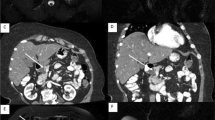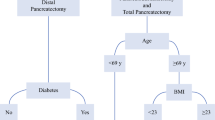Abstract
Background
The international consensus guidelines for the management of intraductal papillary mucinous neoplasm (IPMN) of the pancreas were revised in 2012 Tanaka (Pancreatology 12(3):183–197, 2012), making the indications for operation less aggressive. Therefore, the number of branch duct-type IPMN (BD-IPMN) patients requiring follow-up care is expected to increase in the future.
Methods
The aim of this study was to identify risk factors for malignancy in BD-IPMN patients during the follow-up period. This study included 47 BD-IPMN patients without a mural nodule (MN) at the time of initial diagnosis and who subsequently underwent resection after a follow-up period of more than 3 months. Data for the patients were reviewed retrospectively, and the clinicopathological factors were investigated.
Results
In a univariate analysis, age (≧65 years), an increase in the main pancreatic duct (MPD) diameter, the MPD diameter at resection (≧5 mm), and the occurrence of MN were significantly associated with malignancy. The occurrence of MN was the only significant factor in a multivariate analysis. In addition, 7 of the 17 patients (41.2 %) who only exhibited an increase in the cyst diameter during the follow-up period were diagnosed as having malignancies. All 6 patients who exhibited an increase in the cyst diameter of 100 % or more were diagnosed as having carcinoma.
Conclusions
During the follow-up period, the incidence of malignancy was higher among patients with BD-IPMNs and the occurrence of MN, an increase in the MPD diameter, or an increase ratio of 100 % or more in cyst diameter than the others; resection was recommended for these patients.


Similar content being viewed by others
References
Tanaka M, Fernandez-del Castillo C, Adsay V et al (2012) International consensus guidelines 2012 for the management of IPMN and MCN of the pancreas. Pancreatology 12(3):183–197 Epub 2012/06/13
Itai Y, Ohhashi K, Nagai H et al (1986) “Ductectatic” mucinous cystadenoma and cystadenocarcinoma of the pancreas. Radiology 161(3):697–700 Epub 1986/12/01
Brugge WR, Lauwers GY, Sahani D et al (2004) Cystic neoplasms of the pancreas. N Engl J Med 351(12):1218–1226 Epub 2004/09/17
Tanaka M, Chari S, Adsay V et al (2006) International consensus guidelines for management of intraductal papillary mucinous neoplasms and mucinous cystic neoplasms of the pancreas. Pancreatology 6(1–2):17–32 Epub 2005/12/06
Bosman FT, Carneiro F, Hruban RH et al (eds) (2010) WHO classification of tumours of the digestive system, 4th edn. IARC Press, Lyon
Sobin LH, Wittekind C (eds) (2002) TNM classification of malignant tumours, 6th edn. Wiley, New York
Kang MJ, Jang JY, Kim SJ et al (2011) Cyst growth rate predicts malignancy in patients with branch duct intraductal papillary mucinous neoplasms. Clin Gastroenterol Hepatol 9(1):87–93 Epub 2010/09/21
Maguchi H, Tanno S, Mizuno N et al (2011) Natural history of branch duct intraductal papillary mucinous neoplasms of the pancreas: a multicenter study in Japan. Pancreas 40(3):364–370 Epub 2011/02/04
Yamaguchi T, Baba T, Ishihara T et al (2005) Long-term follow-up of intraductal papillary mucinous neoplasm of the pancreas with ultrasonography. Clin Gastroenterol Hepatol 3(11):1136–1143 Epub 2005/11/08
Irie H, Yoshimitsu K, Aibe H et al (2004) Natural history of pancreatic intraductal papillary mucinous tumor of branch duct type: follow-up study by magnetic resonance cholangiopancreatography. J Comput Assist Tomogr 28(1):117–122 Epub 2004/01/13
Rautou PE, Levy P, Vullierme MP et al (2008) Morphologic changes in branch duct intraductal papillary mucinous neoplasms of the pancreas: a midterm follow-up study. Clin Gastroenterol Hepatol 6(7):807–814 Epub 2008/02/29
Rodriguez JR, Salvia R, Crippa S et al (2007) Branch-duct intraductal papillary mucinous neoplasms: observations in 145 patients who underwent resection. Gastroenterology 133(1):72–79 quiz 309–10. Epub 2007/07/17
Schnelldorfer T, Sarr MG, Nagorney DM et al (2008) Experience with 208 resections for intraductal papillary mucinous neoplasm of the pancreas. Arch Surg 143(7):639–646 discussion 46. Epub 2008/07/23
Sugiyama M, Izumisato Y, Abe N et al (2003) Predictive factors for malignancy in intraductal papillary-mucinous tumours of the pancreas. Br J Surg 90(10):1244–1249 Epub 2003/09/30
Provinciali M, Smorlesi A (2005) Immunoprevention and immunotherapy of cancer in ageing. Cancer Immunol Immunother 54(2):93–106 Epub 2004/11/24
Burns EA, Leventhal EA (2000) Aging, immunity, and cancer. Cancer Control 7(6):513–522 Epub 2000/11/23
Fessler J, Ficjan A, Duftner C et al (2013) The impact of aging on regulatory T-cells. Front Immunol 4:231 Epub 2013/08/22
Vadasz Z, Haj T, Kessel A et al (2013) Age-related autoimmunity. BMC Med 11:94 Epub 2013/04/06
Tanno S, Nakano Y, Koizumi K et al (2010) Pancreatic ductal adenocarcinomas in long-term follow-up patients with branch duct intraductal papillary mucinous neoplasms. Pancreas 39(1):36–40 Epub 2009/09/12
Woo SM, Ryu JK, Lee SH et al (2009) Branch duct intraductal papillary mucinous neoplasms in a retrospective series of 190 patients. Br J Surg 96(4):405–411 Epub 2009/03/14
Yamaguchi K, Kanemitsu S, Hatori T et al (2011) Pancreatic ductal adenocarcinoma derived from IPMN and pancreatic ductal adenocarcinoma concomitant with IPMN. Pancreas 40(4):571–580 Epub 2011/04/19
Acknowledgments
None.
Source of financial support
None.
Conflict of interest
None.
Author information
Authors and Affiliations
Corresponding author
Rights and permissions
About this article
Cite this article
Kato, Y., Takahashi, S., Gotohda, N. et al. Risk Factors for Malignancy in Branched-Type Intraductal Papillary Mucinous Neoplasms of the Pancreas During the Follow-Up Period. World J Surg 39, 244–250 (2015). https://doi.org/10.1007/s00268-014-2789-3
Published:
Issue Date:
DOI: https://doi.org/10.1007/s00268-014-2789-3




